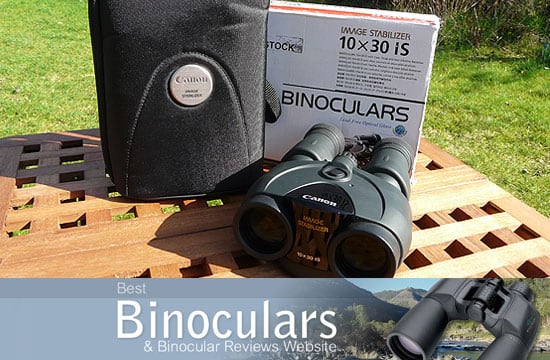

 |
||||||||||||||||||
|
||||||||||||||||||
The standout feature and main selling point of the Canon's 10x30 Image-Stabilized binoculars is obviously their image stabilisation (IS) that helps to reduce and even in some cases eliminate image shake. Image stabilization has been used to great effect on digital cameras for many years, so it is no surprise that the leading IS binoculars would be produced by one of the world's leading photographic brands.
The idea behind making the image that you look through more stable is a great one as the more powerful your set of binoculars, the more your hand vibrations are magnified. As the magnification goes up, the harder it is to keep the image still, until when you start using very powerful binoculars (I am thinking of magnifications above 15x), you have to use something (usually a tripod) to keep them still enough for you to look through them.
The problem with this is carrying a tripod around with you all day is not always the ideal solution and in some cases a tripod will not help, for example if you are on a moving object like a safari vehicle or boat.
With the Canon 10x30 IS Image-Stabilizing binoculars, you can enjoy things like watching wildlife from your safari vehicle or spend hours watching birds without any image shake and all without the need to carry a tripod.
Now, I know that most 10x binoculars on the market don't have any image stabilization and the majority of people, including myself get along without it just fine. I just like to look at it this way: On some of Canon's more powerful models like their 18x50's, without a tripod the image stabilizer is almost essential. On something like these Canon 10x30 binoculars, with a far less powerful magnification, the IS is a nice feature to have but not essential for everyone, there are however some uses where it can be or a real benefit:
Benefits of Image Stabilisation
Below are a few areas that I can think of where even with only a 10x magnification, the image stabilisation on these Canon binoculars would really be a help:
Does the Image Stabilisation Really Work?
The short answer to this is Yes, most definitely. With just a press of a button you will notice a small shudder of the image as it kicks in and then everything is calm. The image is serenely still, and the additional comfort in viewing images like this really can't be overstated.
Take a look at the video below that demonstrates very well just how effective the image stabilisation is. Also worth pointing out is that it was taken through the Canon 8x25 IS binoculars, that have an even smaller magnification than this 10x version.
What is impressive about the Canon 10x30 IS is despite their image stabilizer, they weigh only 600gr/21.2 oz (excluding batteries). This compares very well to other mid sized binoculars and even with batteries they will be lighter than many. Their dimensions are a little on the large side compared to most mid-sized binocular but not too bad, so if you are looking for a really "compact" mid-sized binocular (hope that makes sense!) these may not be ideal for you.
One thing to mention that while these do have a water-resistant rubber coating that does help with a secure grip, they are not fully waterproof or fogproof. This may be something to consider if you are planning on using your optics in a wet environment or places that have rapid and extreme temperature changes. This is a little disappointing because the Image-Stabilizer on these will do a great job of canceling out wave action on a boat. They will be fine if all you are going to get is some spray on them, but not great if you were to accidentally drop them overboard.
Specifically designed Marine Binoculars use lower magnifications (Usually 7x) to help keep the image shake to a minimum, but if you want a more powerful magnification and are sure that you won't get them completely wet, then these may just be what you are looking for. Worth mentioning is that Canon 15x50 IS and the 18x50 IS are designed with a sealed construction and are fully waterproof.
I do like the way the binoculars feel in your hands, they are comfortable to hold and are well balanced, this combined with the IS and relatively low weight must surely mean that these would make an excellent choice if you spend long periods of time using your binoculars. The Stabilizer button is also easily reachable with either hand and so makes activating it really simple.
Interpupillary Distance Adjustment
Unlike most binoculars that have a central hinge that is used to adjust the distance between the eyepiece lenses to suit your eyes (Interpupillary Distance Adjustment), the Canon 10x30IS eyepieces move independently from the body, which works really well.
Eye-Cups
Canon use rubber eyecups on these 10x30 binoculars, which are very comfortable when pushed against your face and because they are fairly soft, do a good job of blocking out light from the sides. They also give you 14.5 mm of eye relief, which should be enough for most eye glass wearers to be able to use these without having to remove your glasses. (to do this you would just roll down the eyecups)
Focusing
Focusing using the central wheel is smooth and very accurate and takes just over 1 full revolution of the dial to go from the near focus to infinity.
The diopter adjustment is located on the right barrel of the binocular. It allows you to adjust the lenses separately to allow for differences in each of your eyes and plays an important part in correctly focusing your binoculars. The ring on the binocular that I tested was tight enough so as not to be easily accidentally moved, but not so tight that makes it hard to adjust. It also has markings on it so that you can easily return them to your setting should it accidentally move or if you were to share your binoculars with someone else who uses a different setting.
Canon Stabilized Binoculars Technology
Canon was the first manufacturer to offer an optical image stabilizer on their binoculars with their IS series. How it works is inside the binoculars, there are two Vari-Angle Prisms that are controlled by a microprocessor: Two sensors detect horizontal and vertical movement respectively and the two Vari-Angle Prisms in both the left and right barrels of the binocular are controlled by a microprocessor to instantly adjust the refraction angle of the incoming light. This system is used in all Canons IS Binoculars.
To stop image shake, you just press and hold a button on top of the Canon stabilized binoculars. Because of the micro computer, these Canon IS binoculars do need batteries and this does add to the weight of the product, although I have already mentioned that these are as light and in some cases even lighter than many other binoculars of a similar size. The advantages of this system compared to other types of stabilized binoculars (Gyro type and the Mechanical type) are that they are relatively compact and light. You also get an immediate response after the image stabilizer is activated and the image is stable even whilst panning.
Whilst I could not use them long enough to test the battery life, I have done some research and have read that the batteries will last for about 20 hours of observation using the stabilizer (you can use the binoculars without it as well). Obviously this will also vary depending on the quality of batter used.
Field Flattener Lenses
The image quality around the edges of your view is a very important point to look at when selecting binoculars. If you look through cheap and inferior binoculars, you will notice that the edge of the view is always fuzzy and out of focus - using these for an extended period of time, your eyes will easily tire and some people can even become sick.
All binoculars in Canon's IS series use the worlds first doublet field-flattener lens. Field Flattener Lenses have the effect of improving the edge sharpness of the image and also lower the distortion by minimizing curvature of the field. Canon go one step further with their exclusive optical design, using two field-flattener lenses, lenses which are normally reserved for high-grade binoculars.
Looking through the binoculars, the results are easy to see as I could not see any colour fringing or softening of the image on the edge of the image that you find in poorer quality binoculars. Very Impressive.
Lens Coatings
The lenses on these binoculars have also been coated with Canon's own Super Spectra multi-coating, which they say improves overall image quality by maximizing contrast and minimizing colour smear. I cannot verify the effectiveness of the actual coating, but can say that the view through these binoculars was impressive. As well as sharp, they were clear and really bright for a binocular with only 30mm objective lenses:
30mm Objective Lenses & Brightness
The most common objective lens size for mid-sized binoculars is 32mm, Canon have however used slightly smaller 30mm objective lenses presumably to save weight and keep the their size to a minimum.
10x32 binoculars have an Exit Pupil of 3.2mm and a Twilight Factor of 17.9, whilst these 10x30 binoculars have a slightly smaller exit pupil of 3.0mm and a Twilight Factor of 17.3, suggesting that these probably won't perform as well as binoculars with the same quality optical components in poor light conditions. It is important to remember that whilst these figures make it possible to compare the performance of different configurations of binoculars in low light conditions, they do not take into account the quality of the prisms, lenses and their coatings.
Field of View
The field of view at 1000 yards is 314ft (105m@1000m) which means they have an angle of view of 6° and an apparent field of view of 60° which is acceptable, but nothing spectacular for a 10x binocular.
Close Focussing
Their close focus distance is 4.2 m/13.8 ft. Which is a little on the far side, I describe anything under 6ft as excellent and so would not recommend these binoculars for things like viewing butterflies or other objects at close range.
Also Included:
Canon don't include objective lens caps with these which is a little disappointing. This is not a problem when transporting them in their case and even though many people don't use lens caps out in the field, it is always nice to have that choice.
These 10x30 Canon binoculars are had a recommended retail price of available for around $590/�499, but you can now pick them up for as little as $350/£300, which makes a huge difference to just how much I like them! I love the image stabilizer, it is far more than just a gimmick and yes it does really work! They are also surprisingly light and if you take into account the quality of the view through them, they do make pretty good value for money.
Weak points? Their weakest point for me was their relatively far minimum close focusing distance and the fact that they are not completely waterproof. The lack of objective lens caps, will also niggle some people out there.
Overall though, if you are looking for the steadiest image possible without the pain of having to carry around a tripod all day, then these optics are ideal.

Reviewed by Jason Whitehead for Best Binocular Reviews
|
Main Specifications & Features:

Below are similar pairs of Binoculars that you may also want to have a look at:
Canons Image stabilization technology, powerful magnification and quality lenses. These are a great pair of binoculars.
General Price Range: (4/6) Mid-High Value Binoculars
Below is a link that will take you to a page with online retailers in both the US and UK that sell Canon 10x30 IS Image Stabilized Binoculars this page makes it easy to compare prices and then to buy from your preferred option:
|
Buy & Compare Prices for the Canon 10x30 IS Image Stabilized Binoculars |
||
US Shoppers |
Canadian Shoppers |
UK Shoppers |
Deutsch Shoppers |
Aussie Shoppers |
Indian Shoppers |

